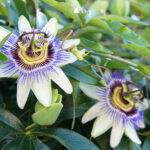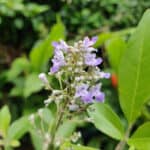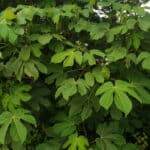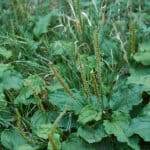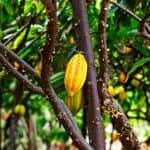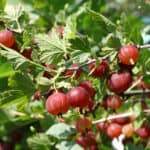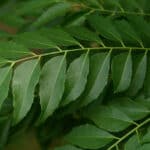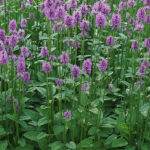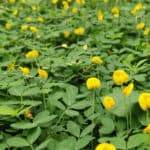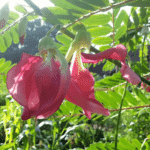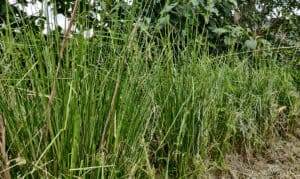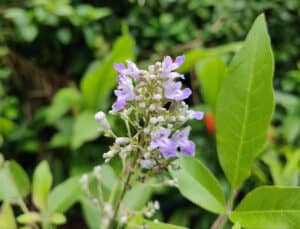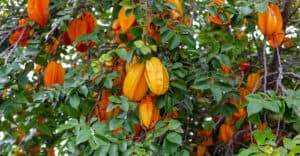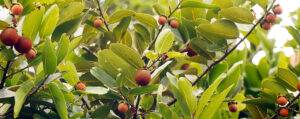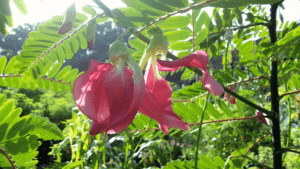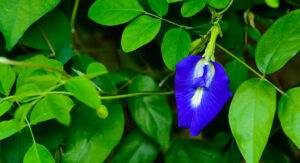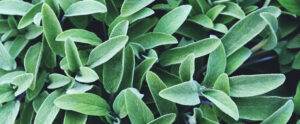Chamomile is the most widely known medicinal herb due to its popularity as an herbal tea. Because chamomile is so well known, it’s easy to see it as nothing more than a comforting and pleasant-tasting herbal beverage you sip on at a coffee shop. While that’s certainly true, there is much more to discover and know about this potent medicinal ally.
Plant Overview
Matricaria recutita is a small herbaceous annual in the Asteraceae family with distinct petite white and yellow flowers. The common name, chamomile, is derived from the Greek word, Kamaimelon. Kamai means ‘ground,’ and melon means ‘apple,’ forming the word ground apple. The name describes its growth structure, which is close to the ground (especially for Roman chamomile), and the sweet apple-like scent of its flowers (Popham, 4).
Its native range extends throughout the majority of Eastern and Western Europe. It has now naturalized in many parts of the world, including North Africa, the Middle East, and temperate regions of Asia. It is also found in parts of Australia and Argentina. Scattered populations have been documented in the US from Maine to Alabama, south Texas, along the Mississippi River drainage, and in the Pacific States (Foster, 36).
Due to the high demand for chamomile flowers and precious essential oil, it is widely cultivated and commercially grown in Hungary, Germany, China, India, the Czech Republic, Egypt, Poland, and Slovakia.
History of German Chamomile
Chamomile has a rich history. The first documented discovery of its use dates back to around 50,000 years ago when it was found in the teeth of a Neanderthal man excavated inside El Sidron Cave in northern Spain.
It has been found in ancient medical texts from Greece, Rome, and Egypt. Its use was mentioned frequenlty by significant herbalists and physicians of their time, including Hippocrates, Galen, Pliny, and Dioscorides. Some sources claim it is one of the many documented medicinal herbs in the Egyptian Ebers papyrus which dates back to about 1550 BC. However, I can’t confirm that chamomile is mentioned in the Ebers papyrus.
In England, chamomile is found in an 11th-century Anglo-Saxon medical manuscript, “The Lacnunga,” which means remedies in Old English. Chamomile is listed as one of the nine sacred herbs in this text, along with nettles, fennel, mugwort, plantain, and others. These sacred herbs were said to protect against disease and “venomous flying things” (poisons).
Chamomile has always had a prominent place in herbalism. From its rich historical use to its modern popularity, we see the significance of this herbal remedy. There is something to be said about herbs that have stayed distinguished throughout the ages.
By growing, tending, and using chamomile (or any medicinal herb), we have an opportunity to connect to wisdom and medicine that is much older and wiser than us. If your lineage traces back to Europe or Egypt, growing and using chamomile can connect you with your ancestors and the medicinal plant knowledge still alive in your DNA.
Plant Description
As a small herbaceous annual, chamomile grows to about 1 to 2 feet tall. It bears an upright branching stem that is bare, round, and pale green with noticeable striations. The alternate feathery leaves are narrow and finely divided (bi – to tripannately compound).
Many are familiar with the characteristic white and yellow chamomile flowers. These sweet-smelling flowers are actually “composite,” which means the flower head is made up of two types of flowers: ray flowers and disc flowers. The yellow part of the inflorescence consists of several tiny tubular disc flowers. The disc flowers are surrounded by white ray flowers. Composite flowers are a distinguishing characteristic of the Asteraceae family, which is why it’s commonly referred to as the ‘Composite family.’
An important identifying characteristic of chamomile is that the receptacle, where the disc flowers sit, is hollow inside. You can identify this by cutting a chamomile flower head in half with a knife. This is important to remember because a few wild plants (most often considered weeds) look identical to chamomile. However, these plants also lack the sweet scent of Chamomile and either have very little scent or an unpleasant scent.
One such plant, Anthemic cotula, commonly known as ‘stinking chamomile,’ looks identical to German chamomile in its growth structure, including leaf and stem arrangement, height, and flowers. This weed is common throughout the United States, has a distinctly unpleasant odor, and lacks a hollow receptacle.
You would think the smell alone would be enough to identify A. cotula, but sometimes the smell is less distinct. I had one growing in my garden bed next to regular German chamomile, and it took me a while to notice the imposter! This flower is considered toxic, so it’s important to distinguish it from German chamomile if it grows in your area, as it may just sneak its way into your chamomile bed!
German Chamomile versus Roman Chamomile
German chamomile is the common species used in North American herbalism, whereas Roman or English chamomile (Chamaemelum nobile, formerly; Anthemis nobilis) is the preferred species in Great Britain. This popular English herb is grown in many British gardens and is used as an ornamental ground cover between stones and walkways.
German and Roman chamomile have similar medicinal actions and are said to be used interchangeably. However, they contain slightly different constituents, as Roman chamomile produces less chamazulene. Chamazulene is the active constituent in German chamomile that renders the royal blue essential oil. Roman chamomile’s essential oil is clear, which shows its chemical profile differs from German chamomile in terms of the concentration of certain constituents. Because of this, I would argue they are slightly different medicinals, but how they differ, I can’t say, as my research has not produced any documented differences.
Roman chamomile also differs from German chamomile in its growth characteristics. Where German chamomile is a short-lived annual, English chamomile is a small, herbaceous, creeping perennial reaching up to 1 foot tall when flowering. The flowers are a bit larger than German chamomiles and bear a solitary flower head on each stalk. German chamomile produces more blooms and blooms more often, making it the preferred species to gain a substantial harvest.
Propagation and Planting
Chamomile does best in northern, cooler climates and grows in zones 3-8. Other sources list the growing zones as 3-6. But, I was able to grow chamomile when I lived in Oregon (zone 8). If you live in a warmer climate, the key to success is to plant your chamomile seeds early when temperatures are still in the forties or fifties.
German chamomile is best started by directly sowing the seed where you wish it to grow. Space the seeds or transplant seedlings about 2 feet apart. Alternatively, you can start seeds outdoors in pots and then transplant them into the garden. The seeds are tiny and light-dependent germinators; sow on the surface of the soil of a well-prepared seedbed and tamp firmly. The optimal germination temperature is around 43-50 degrees. Germination occurs in 4-10 days.
Growth and Care
If your climate is cooler (zones 3-5), German chamomile is best planted in full sun, where it will happily produce flowers throughout the growing season. If you live in a warmer climate, chamomile does well with part shade, especially during the heat of the day. If given proper shade and regular water, chamomile should continue to produce flowers throughout the growing season even in warmer climates (zones 6-8).
Chamomile prefers a soil pH range of 6-8 and does best in well-drained, moist garden soil with low to moderate fertility. Rich and heavy soils should be avoided, as studies show loamy soils produce the most vibrant crops.
As a self-seeding annual, chamomile will continue to come back each year if the growing site is properly cared for and tended.
One thing to be aware of is that different sources will claim varying things about how to grow chamomile. For example, some sources say it won’t do well in warmer climates with daily temperatures in the 80s (Foster, 38), while other sources claim it won’t grow in the shade (Popham, 3). My experience of growing chamomile contrasts both those statements, as my chamomile plants bloomed throughout the growing season with daily temperatures in the 80-90 range and part shade. That year, we had an abnormally cool spring, so perhaps that helped establish the chamomile so they could withstand the hot summer?
Because of the variance, I recommend purchasing local chamomile seeds – if able. That way, you can plant seeds from plants already accustomed to your climate. And who knows, maybe you’ll have a unique experience of your own!
Pests and Diseases
German chamomile is generally disease and pest resistant for the home gardener. Diseases and pests that are an issue with chamomile are more common in large-scale productions where there is less plant diversity.
Nonetheless, chamomile can be affected by various fungal blights, with the most common being powdery mildew. This fungal disease produces a white powder-like film on the leaves. If you live in an area that experiences an annual spread of powdery mildew (usually mid to late summer), your plants may be more vulnerable to its spread. The best way to avoid powdery mildew is to allow plenty of space between your plants for adequate air circulation. Avoid overhead watering to prevent water build-up on the leaves. If any powder mildew shows up, immediately remove affected leaves to help slow/stop the spread.
In my experience, powdery mildew doesn’t seem to damage the plant too much, but it certainly affects the quality of any herbs you wish to harvest.
As far as pests, chamomile can be prone to aphid attacks. This can be prevented by adequate spacing between plants and ensuring plenty of plant diversity in your medicinal garden. Plant diversity helps distract and dissuade insects from attacking certain plants (such as placing aromatic medicinals throughout your garden, such as yarrow). Moreover, diversity brings more predatory insects to help prey on the aphids. In this way, aphids, and other pests, can be controlled naturally through a healthy and diverse ecosystem.
Harvesting
The medicinal part of chamomile is the flower head. Let it be known that harvesting chamomile flowers is as tedious as tedious can be. This is because, to harvest chamomile flowers, you need to snip or pinch off each individual flower head at the base of the calyx. Even just a few plants produce substantial blooms.

It is slow and steady work that shouldn’t be rushed. I find the best way to go about harvesting chamomile flowers is to let it be a relaxing, meditative experience. Sometimes, I would listen to music, a book, or a podcast to help the time pass. Other times, I would practice being as present as possible to the process and the natural world around me. The slow work was also an opportunity to practice learning the medicine of chamomile from the plant itself.
Chamomile flowers can be dried or used fresh for a tincture. Dry them in hanging baskets, on screens, or in a dehydrator at a low temperature.
Medicinal Uses
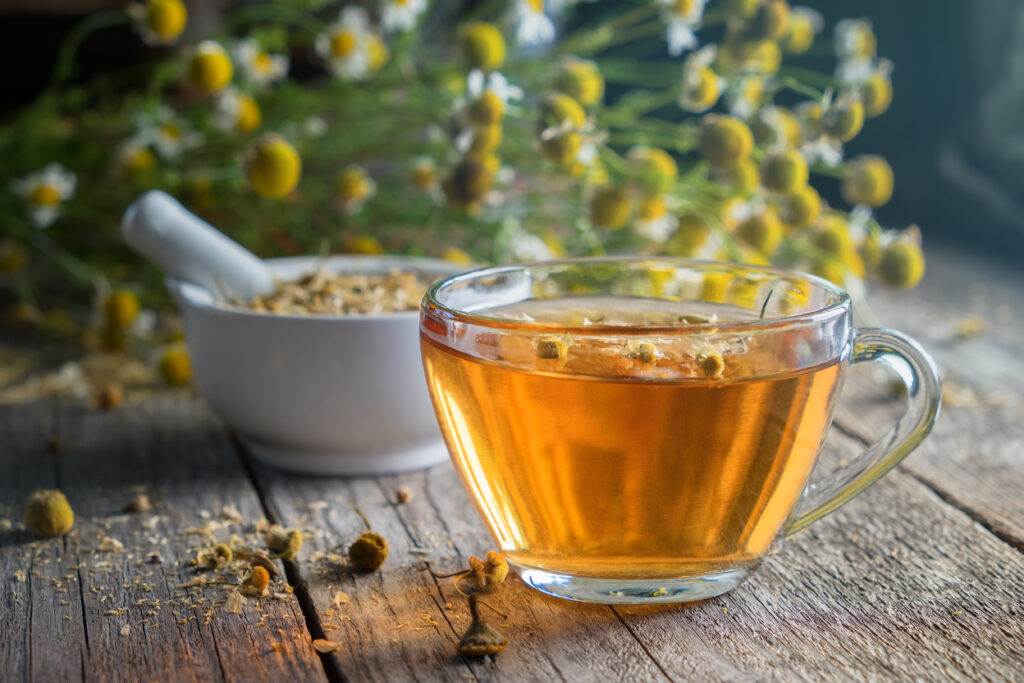
Medicinal Actions:
- Nervine sedative
- Bitter
- Carminative
- Anti-spasmodic
- Relaxant diaphoretic
- Emmenagogue
- Anti-inflammatory
- Antimicrobial
- Vulnerary
Energetics: Slightly cooling, drying, relaxant
Parts Used: Flowers
Medicinal preparations: Infusion, tincture, soak, compress, infused oil, essential oil
Chamomile has a profound influence on the nervous and digestive systems, and the combined influence on these systems is where Chamomile shines. As a nervine sedative, it calms the central nervous system, helping it to switch from the sympathetic to the parasympathetic nervous system. Chamomile is not overly sedative, so it won’t make you tired or groggy. This makes it an invaluable remedy for daily anxiety, stress, or irritability. That said, it’s often used before bed to help one calm their thoughts and relax, which promotes deeper and more restful sleep.
As a digestive aid, chamomile is both bitter and carminative. Bitters are cooling remedies that stimulate bile secretions and help “wake up” the digestive system for proper metabolism. Through their cooling effect, they bring the vital force down and in, thus draining fluids and promoting increased digestion. Carminatives are generally warming remedies (though chamomile is unique in that it’s a cooling carminative) that bring circulation to the digestive tract. They help expel wind (gas, bloating) and ease digestive cramps, spasms, and painful griping sensations. Not many herbs are both carminative and bitter, making chamomile a formula unto itself for digestive complaints.
The nervous and digestive systems directly affect each other. For proper digestion to occur, including the breakdown and distribution of nutrients, the nervous system needs to be in the parasympathetic mode, a.k.a the rest and digest mode. If someone is stressed out or anxious and their nervous system is activated, they won’t be able to properly digest their food, which usually leads to indigestion and painful cramps, gas, or bloating. Chamomile helps calm the nervous system, and through its carminative/bitter properties, it supports proper digestion quickly and effectively.
“All tense and restless conditions associated with digestive upset is where Chamomile will really shine – because a person’s stomach or intestinal distress can be the cause or the product of anxiety, stress, or depression. That’s because the brain and the gastrointestinal (GI) system are intimately connected. Thus, when we calm our digestion, our nerves often follow suit; and when we settle the nerves, our digestion typically improves. In this way, I think of Chamomile as really working on the gut-brain axis.”
Sajah Popham, School of Evolutionary Herbalism, Chamomile Materia Medica
As a vulnerary and anti-inflammatory herb, chamomile is beneficial for any digestive upset associated with inflammation and or damage to the gut wall. Its wound healing (vulnerary) qualities indicate it for nicks and tears in the mucosal lining in the gut, which can lead to leaky gut syndrome. Along with the above actions, its antimicrobial properties indicate it for ulcers, in which it can be used in formulation along with other vulneraries and demulcents such as calendula (Calendula officinalis) and marshmallow root (Althea officinalis).
For the respiratory system, chamomile’s high essential oil, which lends its antimicrobial properties, can help relieve upper respiratory infections. It is especially beneficial for relieving inflammation in the sinuses, which can be achieved through inhaling the steam from a hot cup of chamomile tea or doing a steam bath with chamomile essential oil. Its relaxant diaphoretic properties indicate its use for breaking a fever, especially when the fever is associated with tension, irritability, feelings of heat, muscle cramps, and restlessness.
Topically, chamomile is commonly used as an eye wash or compress to relieve eye inflammation or conjunctivitis. This can be achieved by placing a tea bag over the affected eye(s). Make sure to use two tea bags – one for each eye. Alternatively, you could soak a cotton ball in a well-strained, concentrated chamomile infusion and apply it that way. The diluted essential oil, and infused oil, are used for scrapes, cuts, burns, or topical inflammation.
Another important aspect to know about chamomile is its beneficial use as a children’s remedy. Through its gentle, safe, and soothing qualities, it helps calm hyperactive children and fussy, colicky little ones. It is well-indicated for tantrums, restless sleep, and irritability. These same psychological indications are beneficial for “childish” adults. It is also used for teething pains and can be used this way by soaking a cloth in chamomile tea, which the baby can chew on.
“Chamomile has a long history of use in folk medicine as a sedative for cross, whining, irritated babies, and the problems incident to babyhood, such as teething, earaches, and intolerance to pain. The child is peevish, whining, complaining, angry, demands attention and petting. Demands a toy, then throws it on the floor. Whatever the age, the behavior is unmistakable. “Babies of any age,” as I say.”
Matthew Wood, The Earthwise Herbal: Volume 1
Lastly, chamomile has an affinity for the female reproductive system through its anti-spasmodic, emmenagogue, nervine, and bitter properties. As an emmenagogue, it stimulates menstruation and blood flow, which can help ease cramps and spasms, along with its anti-spasmodic properties. Its potent nervine qualities are beneficial for PMS symptoms and gives the nerves a comforting and soothing touch while bleeding. Its bitter properties stimulate liver activity, which can become overrun and stagnant with hormones (which leads to further hormonal issues).
Final Thoughts
After uncovering more of chamomile’s medicine in this growing guide, it’s no surprise that it’s gained worldwide popularity as an herbal beverage tea and essential oil.
As an easy and happy little garden plant, its bright sunny flowers will bring you delight and delicious homemade teas. I hope this guide has inspired you to bring chamomile into your life and garden! Through intimate connection, the depth of its medicine can be discovered.
May your chamomile plants flourish and bring you many happy days.

